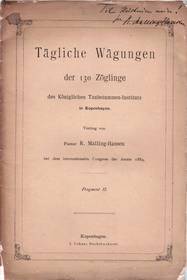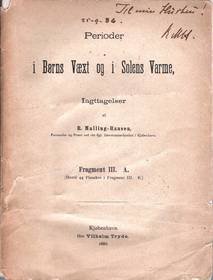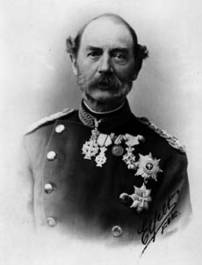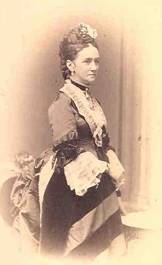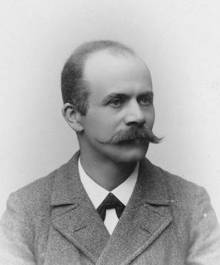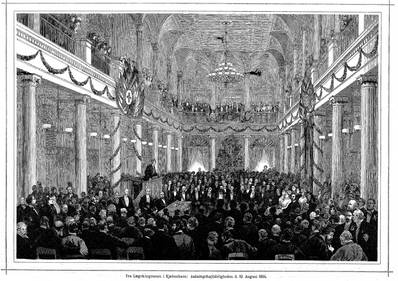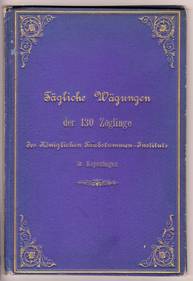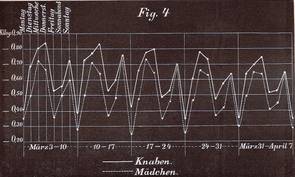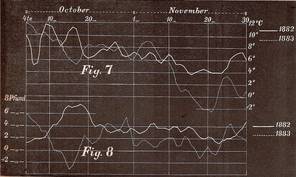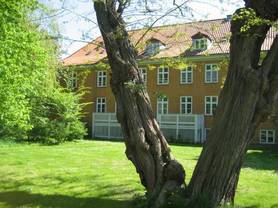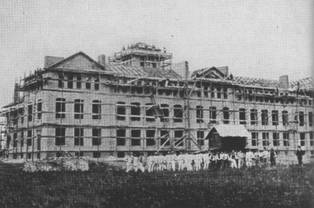Periods in the growth of children
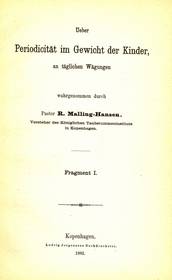
- The results of Malling-Hansen's scientific research was published Danish and German in three books - called fragments I, II and III. This is Fragment I, published in 1883. Copyright: Døvehistorisk Selskab
As the principal of the Royal Institute for the Deaf-mutes, Rasmus Malling-Hansen's concern was not only the children's education. He cared about everything that could affect on their welfare, such as their possibilities to get fresh air, their clothings and also their diet.
In 1877 Rasmus Malling-Hansen wanted to investigate if the nourishment that the children were offered at the Institute was sufficient, so he started to measure the height of a small group of children each day, to provide exact data about their growth over a longer period of time. He kept on measuring for about 6 months, and the results were so unexpected that Malling-Hansen soon started a scientific investigation, which included the measuring of the height of a group of 23 children 8 times every day. When the project was completed, he had made close to 27.000 measurings. Malling-Hansen understood that he was on the trace of the discovery of a totally unknown phenomenon; that the children grow in periods - and not in an even pace.
For several reasons the preparation of the figures had to be postponed, but in the beginning of the 1880's, Malling-Hansen decided that the nature of his discoveries, caused him to also investigate the children's increase in weight. To shorten the time needed to perform the weighings, Malling-Hansen had some large weights made, where he could weigh up to ten children at a time, and through a whole year in 1881/82, he weighed all the girls and all the boys at the Institute(130 children) seperately each day, the boys even twice each day.
The results soon confirmed what he had previously discovered; the growth of the children was not a constantly ongoing process throughout the year, but that the children grew in periods, and this was totally unknown to science up til then. Malling-Hansen saw that the growth was affected by some unknown factor, and he also started measurements of trees, and here he found again the same factor. He also was in contact with scientists around the world, who reported their results from different measuring projects initiated by Malling-Hansen.
There were still many unanswered questions to investigate further when Malling-Hansen died, but in 1886 he published a book where he presented the results of his studies. The book was called "Perioder i Børns Vækst og i Solens Varme", and here he presented his idea, that it was the variations in the rays of the sun, that was the factor that caused the variation in the growth of the children, an in nature as such. His discoveries became well known not only in Denmark, but also internationally, and his book was also translated into German. In 1884 he had also held a lecture on a scientific conference in Copenhagen, attended by scientists from all over the world.
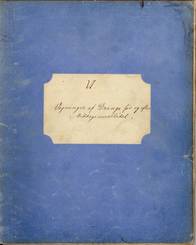
- During all the years of measuring and weighing the children at the Institute, Malling-Hansen and the teachers who assisted him, wrote down the results in notebooks in different colours. Copyright: Døvehistorisk Selskab
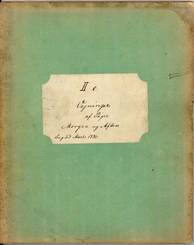
- The destity of these coloured notebooks has been mystery, because RMH's son-in-law, Michael Agerskov, 1870-1933, wrote in his book "Some psychic experiences in 1922 that a part of them was burned and the rest donated to some Danish scientists in 1911. Copyright: Døvehistorisk Selskab
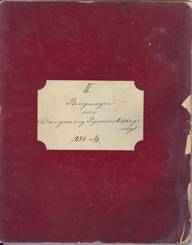
- On the General Assembly in 2008 the three specimens shown here turned up in the exhibition that Jan William Rasmussen in Døvehistorisk Selskab had prepared to the meeting. What has happened to the rest of the notebooks will be a subject of further investigation. Maybe the scientists returned the books to the Institute? Copyright: Døvehistorisk Selskab
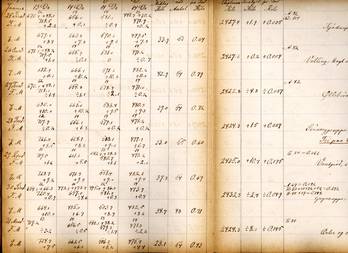
- The results were noted down by teachers that assisted RMH in the weighing and measuring. On large weights they could weigh up to ten children at the time and then calculate the average. As can be seen from the notes, RMH was still working on his project in 1890. Copyright: Døvehistorisk Selskab
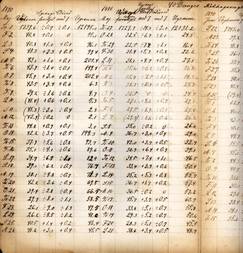
- Michael Agerskov tells in his book that the reason why some of the material was burned was that the daughters didn't want someone else to draw the wrong conclusions from their fathers preliminary notes. RMH had also destroyed some of the notes himself before he died. Copyright: Døvehistorisk Selskab
A Royal weighing at the Royal Institute - in 1884
One of Rasmus Malling-Hansen's son-in-laws, Fritz August Bech worked for many years as a teacher at the Royal Institute for the deaf-mutes, and he became one of Malling-Hansen's most dedicated admirers, wrote several articles about the life and work of Malling-Hansen, and thus contributed to keeping his memory alive in Denmark.
It is well known that the Danish King was a great admirer of Malling-Hansen's work, and they met on several occations. In his autobiography Fritz Bech writes about a Royal event that took place at the Institute in 1884.
Malling-Hansen had been notified several days ahead that the Royal couple would honour the Institute with a visit, and the most thorough preperations had of course been made. Everything was clean and tidy, and the teachers wore their black suits with a white glove on the left hand.
When the Royal carriages with the servants in red jackets were spotted, everybody wanted to get a view of the King and the Queen, but before the welcoming gestures, the children were sent to the classrooms, and the Royal couple was invited to attend the lessons. After they had seen how the children were taught, Queen Louise, who had read about Malling-Hansen's weighings of the children, wanted to see the large weight that had been made for the project. So Malling-Hansen guided the procession, which also included the Royal daughter-in-law, the beautiful Queen Olga of Greece, and her two sons, Crownprince Constantine and Prince Georg, who were 16 and 15 years of age, into the dormitory where the weight was situated. Queen Louise showed great interest in the weight, and also wanted to try it herself, and Fritz August Bech reveals her weight to have been 47 1/2 kilos.
While they had been engaged in the weighing, nobody had taken any notice of the young princes, but now they discovered that the young men had disappeared, and everybody looked for them everywhere. And the search did not end before they were spotted in the kitchen of the Institute, where they were seated -enjoying a meal of traditional Danish food, bread made of rye - dipped in grease!
Article from The Times, Thursday, 7.th of January 1886
A NEW START IN PHYSIOLOGICAL RESEARCH.
(From a correspondent at Copenhagen)
During the International Medical Conference held in Copenhagen in the summer of 1884, a paper read by the Rev. Malling Hansen, Principal of the Danish Institution for the Deaf and Dumb, was listened to with marked attention and interest. It gave the results of the daily weighings and measurements of height which he had carried on for nearly three years on the 130 pupils, 72 boys and 58 girls, of the institution, and demonstrated facts as to the development of the human body during the period of childhood that perfectly startled and astonished the assembled medical authorities, opening an entirely new field for investigation and reflection. Since then Mr. Hansen has continued his observations, and though he has yet a tremendous amount of work before him, he believes himself able to state now the outlines of the results he has obtained. Before entering upon these it may be proper to explain that the children are weighed four times daily, in batches of 20, in the morning, before dinner, after dinner and at bed time, and that each child is measured once a day. The scales and appliances used are ingeniously contrived, allowing the whole business to be finished in five to ten minutes, and sufficiently accurate to indicate even the smallest difference. The children have taken immensely to the thing; they are eager to perform their part, and all fingers are astir to repeat the numbers, rejoicing at every marked change.
The common impression is, no doubt, that increase in the bulk and height of the human body during the years of growth progresses evenly all through the year. This is not so. Three distinct periods are marked out, and within them some 30 lesser waverings have been observed. As for bulk, the maximum period extends from August until December; the period of equipoise lasts from December until about the middle of April; and then follows the minimum period until August. The lasting increase of bulk or weight is all accumulated during the first stage; the period of equipoise adds to the body about a fourth of that increase, but this gain is almost entirely spent or lost again in the last period. The increase in height of the children shows the same division into periods, only in a different order. The maximum period of growth in height corresponds to the minimum period of increase in bulk, and vice versa. In September and October a child grows only a fifth of what it did in June and July. In other words, during a part of the year, autumn and beginning of winter, the child accumulates bulk, but the height is stationary; in the early summer the bulk remains nearly unchanged, but the vital force and the nourishment are expended to the benefit of height. While the body works for bulk, there is rest for the growth, and when the period of growth comes, the working for bulk is suspended.
The human body has, consequently, the same distinctly-marked periods of development as the plants. Mr. Hansen has extended his daily measurements also to a number of trees in the garden of his institution, and has convinced himself, that here also a period of growth in length, as represented by the branches, twigs and tops alternates with another of increase in bulk – that is, in the circumference of the trunk, followed by a third period of equipoise and rest. In April and May the entire force was expended in the lengthening of the branches, while the thickness of the trunk remained stationary; all through May the most exact measurement failed to discover any increase of bulk. But in June until the middle of July, when the new twigs had been all formed, it was the trunk that absorbed the nourishment from the roots and bulged out. Then came the period of rest and inactivity.
It was stated above that, within the three chief periods of the human (or rather the infantile) body, the observations had pointed out some 30 smaller waverings of more passing nature. The ordinary movement may be subjected to disturbances, a swifter or slower increase, sometimes even positive loss. These waverings prove to be subject to constant laws and independent of accidental or local influences; they return exactly in the same manner and present the same features. One constant relation can be pointed out between these waverings and the movements of temperature in the outer air. If the thermometer rises steadily through several days, the increase in weight also becomes greater, but not equally from day to day; the second day the increase becomes double, the third day three times as much, and so on, until there is a fall of the temperature. If it grows colder there is a decrease in weight (or a lesser increase), but again on the second day double, the third day three times as much, and so on, until a new change of temperature intervenes. The effect of the short periods of change in the thermometer is, consequently, just the contrary of that observed in the longer period. A higher temperature is favourable to increase in weight or bulk; a lower counteracts it, if considered singly; while the warmer seasons, spring and summer, put a stop to that form of growth, leaving it to autumn and winter to favour it.
Mr. Hansen has not restricted himself to the set of pupils in the institution intrusted to his care. He has caused corresponding observations to be made also in several other places, where a number of children were subjected to the same regime and the same conditions of life. An orphan school in Copenhagen [1], another deaf-mute institution in Jutland [2], and a village school [3] have under his instructions carried out a series of investigations, for which a subvention has been granted out of public funds. The results obtained confirm in a most surprising manner his own. In the graphic representation of the observations the curves from the different fields of investigation follow each other very closely, mounting and descending under the evident influence of identical laws. He is still engaged upon his arduous task and working out the many different problems meeting him on his way. Physiologists will, however, hardly be inclined to accept all his facts or to subscribe to all his deductions. It is only right that they should judge for themselves, verify the observations, and submit the deductions from them to a careful trial. If it turns out that they are proved, then various conclusions of high importance for the hygienic treatment of children are to be drawn. At all events, Mr. Hansen may claim to have opened an entirely new and undoubtedly fertile field for exact physiological research.
[1] CB: Probably ”The Royal Orphanage”.
[2] CB: The Royal Institution for the Deaf-mutes in Fredericia, established in 1880, where RMH was vice-director.
[3]: SA: What village school this is, we don’t know yet. Both RMH's brothers were also teachers and it may well have been one of them who carried out this investigation for their brother. Hopefully further research will reveal some more facts about this.
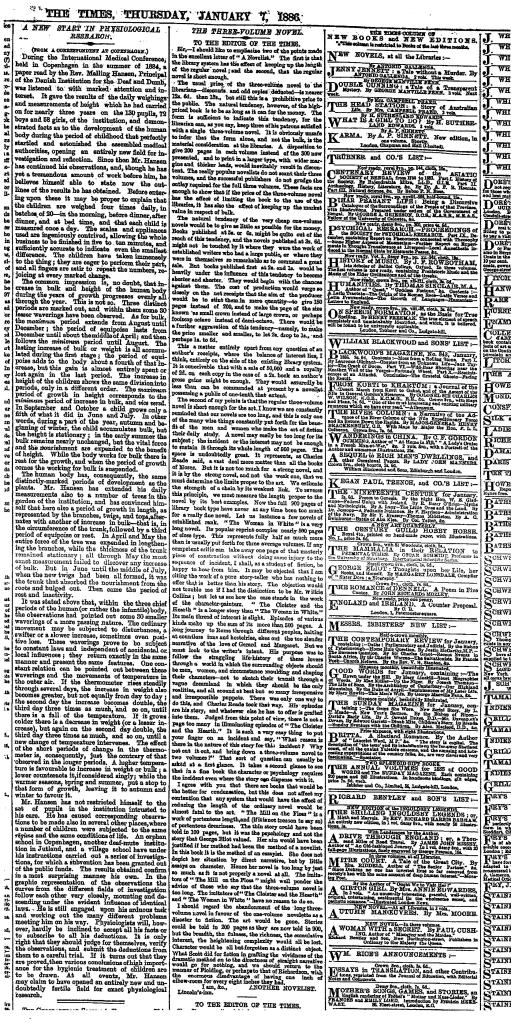
- Malling-Hansen's publications reached out to a large public, and was reviewed in a number of foreign scientific publications and newspapers. Even the world wide English newspaper "The Times" published this article about Malling-Hansen's research on Jaunary the 7.th 1886 called: "A new start in physiological research". "The Times" also mentioned the results of Malling-Hansen's work among the most important new scienetific discoveries in 1885.
Oslo 10.12.06
Sverre Avnskog

